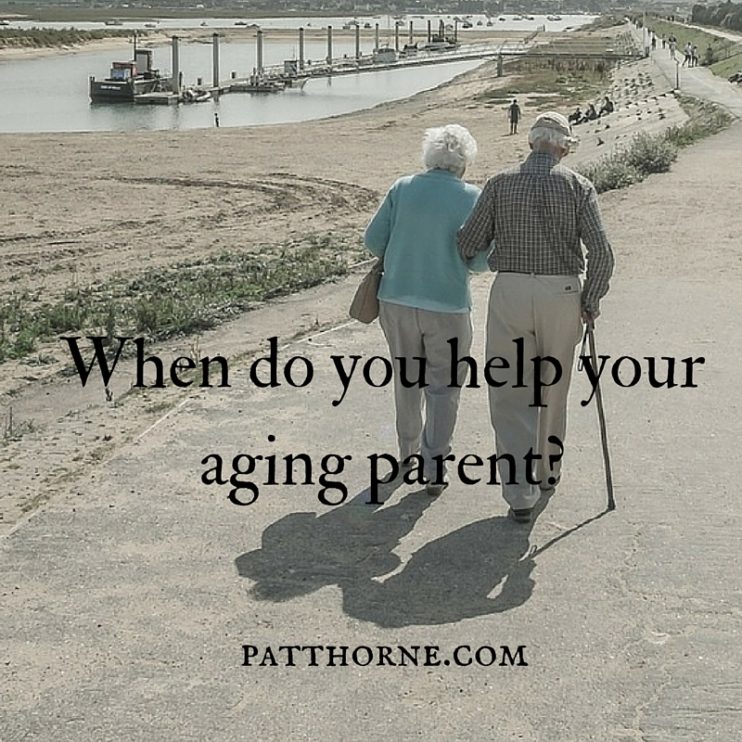The most challenging question facing family care givers is knowing when to step in and take care of an aging parent and when to leave well enough alone. As we care for our loved ones we want our help to be received with a “thank you so much” and not “mind you own business, I can take care of myself”. This can be very tricky waters to navigate successfully and has lead to many unnecessary family conflicts.
Normal Aging
As a family caregiver it is important for you to really know for whom you are caring. Whether you are helping an aging parent, or your elderly spouse, caregivers need to know what they can and cannot do for themselves. There are normal changes that occur as we age which gradually make it more difficult for someone to function independently. Many of these changes are gradual and are fairly predictable. When illness or injury is added into the mix, aging independently becomes far more complicated and will change things quickly. Family caregivers need to be prepared for both. So how do you determine and predict your loved ones physical needs?
Physical Ability
When evaluating your aging parent’s physical ability we are generally focusing on their ability to function independently in their day to day activities. How well or easily do they get around, walk, see, hear, drive, prepare meals? Are they struggling with any chronic symptoms due to an injury or medical condition? For these purposes we are assuming that your loved one is able to think and reason clearly, those issues I will address in a future post. For now we are only focusing on answering the question “Are they safe to live or be alone?” And to do that you need to assess their ability to physically function independently in the some keys areas. Each has an impact on a person’s ability to get around, take care of their personal needs, maintain their home and most importantly remain safe alone.
Mobility
Several factors impact a person’s mobility, which will affect their ability to function independently and these include vision, balance, muscle strength and stamina. Normal aging will impact and diminish each of these abilities and combined can severely limit a person’s ability to navigate through the world on their own. Chronic illnesses not to mention physical injury only further complicate matters.
Vision
We all know too well how vision weakens with age as we struggle to read “fine print” and need to rely on “off the rack readers”. But what we are less aware of is how our range of vision also begins to shrink creating “fuzzier edges” and thus narrowing our peripheral vision. Diminished peripheral vision significantly impacts our depth perception, which is our ability to judge height, depth and width, essential skills needed to safely navigate the world. As one ages it is not unusual to start to bump into the edges of things having misjudged the space to walk past an object. Tripping more often over rugs, steps and curbs because of misjudging how high to lift their foot or the distance down from the curb to the street. Driving is also effected by changes in vision making it more difficult and stressful to see clearly at night or low light, or oncoming side traffic when merging or changing lanes, as well as judging distance when moving in reverse.
Balance
Our ability to remain stable while walking or standing is influenced more by physical conditions than normal aging. Although as we age we are more easily thrown off balance and fall more often is usually the result of vision changes. Someone who is experiencing regular falls or chronic imbalance might be experiencing symptoms of an underlying medical condition. Blood pressure changes, shortness of breath, inner ear issues as well as medications may make one dizzy or light headed making it difficult to maintain balance.
Muscle Strength
Our muscles tend to weaken as we age, so our ability to bear our own weight, lift an object or stand up from a chair may become more difficult. The elderly also tend to be more sedentary so muscles with atrophy from lack of use. Those struggling with joint diseases such as arthritis causing stiff or painful joints will also find it difficult to move easily. Muscle weakness or joint pain in the hands or arms makes it difficult to turn knobs, open jars or doors, or to lift and carry even light objects. Chronic illness like heart and lung disease will greatly diminish a person’s stamina and limit their endurance. They may not be able to walk very far or climb a lot of stairs without having to stop to rest.
Some Solutions
In spite of some diminished physical capacity many elderly can continue to live independently with some simple modifications. Strategically placed grab bars, good lighting, large print, rearranging furniture and rugs all go a long way to maintain independence while preventing accidents. A cane is useful for someone with vision issues so they can test the ground before they step. A walker is the best for those struggling with their balance. Unlike a cane, the two handed design evenly distributes a person’s weight thus maintaining balance. Walkers with seats are helpful for those with muscle weakness as well as low stamina as it provides an immediate place to sit a regain their strength. A wheelchair is a practical solution for those with significant muscle or joint impairment as well as significantly diminished endurance.
Check out the website www.ThisCaringHome.com for more ideas and solutions on home safety.
Summary
Your role as caregiver is directly related to your loved one’s ability to physically function independently. Having a clear understanding of how well they can manage their day to day personal needs including getting in and out of a bathtub, as well as their ability to shop and prepare a meal, doing the laundry and other basic household chores. Obviously the more they can do for themselves the less you need to help. It is important to have an open and honest discussion with your loved one about what they are struggling with and working with them to implement practical solutions. And to discuss with them how they would like to handle any inevitable change. It is best to have a plan in place for when they unable to do for themselves and an agreement on when and how that plan will be put in place.
So until next time take care of yourself and remember – there is “help for the journey”.






